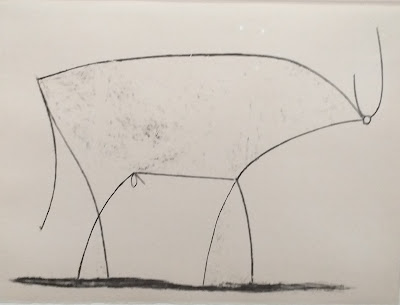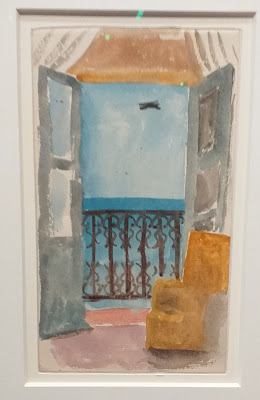 |
| Portrait of Françoise, 20 May, 1946 pencil, charcoal and coloured crayon on paper, Musée Picasso-Paris |
The Exhibition poster features Picasso's mistress Françoise Gilot, artist and author of "Life with Picasso", nick-named by Picasso 'la femme-fleur' (flower woman). The Pompidou Centre organized an inspiring exhibition, showing Picasso's infinite creativity.
 |
| Picasso Exhibition January 2024 at Pompidou Centre |
The setting was breath-taking:- Picasso in the middle of vast views of Paris seen from the top floor of the Centre Pompidou. It was an open-plan exhibition where the visitor could meander from drawings to etchings, huge colourful paintings, tapestry and sculpture, watch Picasso on screens inventing his works and then wander round again.
,%201900.jpg) |
Dans la loge, Paris, 1900 (In the dressing room) pastel on paper
Picasso Museum, Barcelona |
Some examples of Picasso's early work were loaned from Barcelona, like the intensely colourful pastel above; many are permanently at the Picasso Museum in Paris:
 |
| Portrait of Olga, 1921 pastel and charcoal on paper Musée Picasso-Paris |
Picasso's first wife, Olga, whom he met through the Russian ballet in the South of France, is seen in serene mood here, unlike later anguished looking depictions of her. Other works had come from further afield, including several from German museums:
 |
| Le Roi, (the King) 1905 pastel on paper, Staatsgalerie Stuttgart |
Picasso's largest pastel is normally to be seen in the Orangerie Museum in Paris:
 |
| L'Etreinte, Barcelone, printemps 1903 (The Embrace, Barcelona, spring) |
In his inimitable way, Picasso expresses the misery of the naked couple, their faces hidden. He can be expressive on a small scale too- his cross-looking chicken is drawn in one continuous line:
 |
| Le Poussin, (chicken) Paris, May-July 1907 chisel engraved wire wood, print with gouache |
Like the chicken, his "Woman in Armchair" from the Picasso Museum in Paris, uses a flowing line. It gives the effect of an engraving but is in fact a marvelously accomplished ink drawing:
 |
| Femme assise dans un fauteuil (Woman sitting in an armchair) 1926/27 |
Picasso and Olga lived in bourgeois style near the Champs Elysées, as their dining room suggests:
 |
| La salle à manger de l'artiste rue de la Boétie (Artist's dining room) Paris 1918-19 Gouache, ink and pencil, Musée Picasso-Paris |
A large tapestry was created in the 1960s, based on a pastel drawing of the '30s by the master, entitled "Woman with pigeons"
 |
| Femme aux pigeons (Women with pigeons) tapestry 1966-7 Picasso Museum, Antibes |
The tapestry, on loan from Antibes, was shown next to the large pastel drawing kept in the Pompidou Centre. Picasso did not specially intend to have tapestries made from this work; the result is a soft harmony of colours, woven in wool.
 |
Portrait de Jacqueline au fauteuil, Cannes 11-19 dec 1958 (Jacqueline in armchair)
lino-cut print. Musée Picasso-Paris
|
Picasso's second and final wife is seen here portrayed in bold bright strokes. The design has a savage feeling to it, expressed by the gouged out lines of the lino-cut. It is a vibrant work by Picasso from the 1950s.
 |
Tête qui pleure au mouchoir. Post-scriptum à Guernica, Paris, 4 july 1937 (Weeping head with handkerchief) Ink on paper Museo Reina Sofia, Madrid
|
One of the many studies Picasso did around the subject of his masterpiece "Guernica", the above drawing shows how expressiveness can be taken to its paroxysm.
 |
| Tête de faune, 1937 (faun head) Ink and wax crayon on paper Museum Berggruen Berlin |
Picasso sometimes dramatized himself as faun or minotaur. Here he uses strident colour harmonies and stylized lines to give his subject a challenging gaze. The following two portraits of a woman and Dora Maar, Picasso's mistress during the painting of Guernica, were on loan from Germany and Switzerland respectively.
 |
| Buste de femme au chapeau (Woman with hat) 1938 pencil, ink and charcoal Museum Berggruen, Berlin |
.jpg) |
| Femme assise dans une chaise (Dora) (woman seated in a chair) 1938 Ink, gouache and coloured chalk Fondation Beyeler, Switzerland |
A few years previously, Picasso's relationship with Marie-Therese Walters inspired him to produce such sculptures as the one below:
.jpg) |
| Tête de Marie-Thérèse, 1931 |
The soft curves of Marie-Therese contrast with the spiky sophistication of Dora Maar. During the war years, Picasso did some rather anguished works. His serenading mandoline player and distorted nude are seen against a dark claustrophobic background:
 |
| L'Aubade (Dawn serenade), 1942 Pompidou Centre |
The bird inside the female musician represents the hope of freedom during the oppression of the war years, when Picasso lived in occupied Paris.
 |
| Maurice Thorez: photo of Picasso drawing on Jeannette Veermeersch's knee, 28 Aug. 1950 |
As proof that Picasso could use any material or support for his art, some photos on display were of his playful drawings on an acquaintance's leg!
Picasso was capable of creating the most detailed realist painting, as in his "Harlequin":
 |
| Arlequin (Harlequin) 1923 Oil on canvas Pompidou Centre |
He was also adept at transforming a realistic scene to a schematic or minimalist drawing, as in his series of lithographs of bulls on loan from the Picasso-Paris Museum:


.jpg)
Picasso metamorphosed several works by older artists, adding drama for example to the Cranach portrait of a girl:
.jpg) |
Portrait de jeune fille (Portrait of young girl, after Cranach the younger) Cannes,
4 July 1958 lino-cut print Bibliotheque nationale de France
|
 |
| Lucas Cranach the younger: Female portrait 1564 Kunsthistorisches Museum, Vienna |
The Cranach was not in the Pompidou centre exhibition; its home is Vienna.
A small sized watercolour -as limpid and simple as possible- depicts the view out of the window when Picasso was living in Saint-Raphaël:
 |
| Fenêtre ouverte sur la mer et avion dans le ciel (window open on the sea and a plane in the sky) Saint Raphaël, 12 oct 1919 watercolour on paper Musée Picasso-Paris |
Decidedly Picasso was an artist for all tastes. This is just a sample of the works on show at the Pompidou exhibition, demonstrating the amazing range of perhaps the greatest artist of the 20th century, on the occasion of the fiftieth anniversary of his death.
Picasso, Dessiner à l'Infini (Drawing to Infinity),
Exhibition at the Pompidou Centre from 18th October, 2023 to 15th January, 2024.
**********************


,%201900.jpg)











.jpg)
.jpg)



.jpg)




.jpg)

Comments
Post a Comment